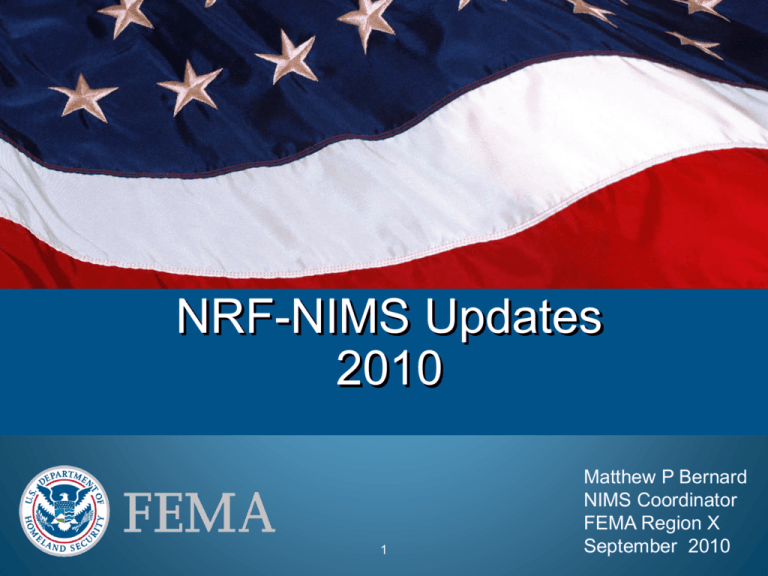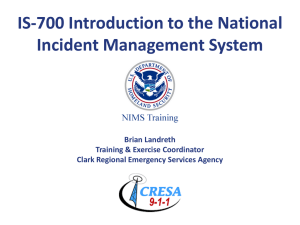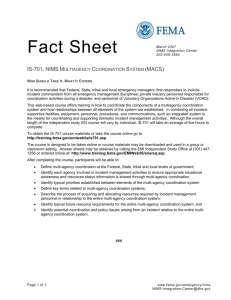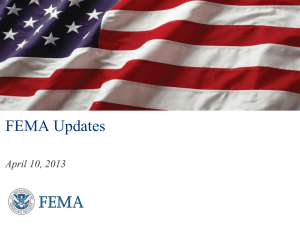Matt Bernard, National Incident Management System-NIMS
advertisement

NRF-NIMS Updates 2010 1 Matthew P Bernard NIMS Coordinator FEMA Region X September 2010 National Response Framework • Purpose – Guides how the nation conducts all-hazards incident response • Key Concepts – Builds on the National Incident Management System (NIMS) with its flexible, scalable, and adaptable coordinating structures – Aligns key roles and responsibilities across jurisdictions – Links all levels of government, private sector, and nongovernmental organizations in a unified approach to emergency management – Always in effect: can be partially or fully implemented – Coordinates Federal assistance without need for formal trigger 2 Focused on Response Achieving a Goal Within a Broader Strategy • Response – Immediate actions to save lives, protect property and the environment, and meet basic human needs – Execution of emergency plans and actions to support short-term recovery • National Strategy for Homeland Security – guides, organizes and unifies our National homeland security efforts – Prevent and disrupt terrorist attacks; – Protect the American people, our critical infrastructure, and key resources; – Respond to and recover from incidents that do occur; and – Continue to strengthen the foundation to ensure our long-term success. 3 How the Framework is Organized Core Document Doctrine, organization, roles and responsibilities, response actions and planning requirements that guide national response Emergency Support Function Annexes Mechanisms to group and provide Federal resources and capabilities to support State and local responders Support Annexes Essential supporting aspects of the Federal response common to all incidents Incident Annexes Incident-specific applications of the Framework Partner Guides Next level of detail in response actions tailored to the actionable entity www.fema.gov/nrf 4 State, Tribal & Local Leadership and the Framework Effective, unified national response requires layered, mutually supporting capabilities States are sovereign entities, and the Governor has responsibility for public safety and welfare; States are the main players in coordinating resources and capabilities and obtaining support from other States and the Federal government Governor Homeland Security Advisor Director State Emergency Management Agency State Coordinating Officer State & Tribal Governments Local Governments Indian Tribes. Tribes are sovereign entities. The tribal leader is responsible for the public safety and NRF welfare of The people of that tribe. As authorized by tribal government, the tribal leader is responsible for Federal Coordinating tribal resources, working within the Government tribal legal framework, negotiate mutual aid and assistance from other tribes or jurisdictions and communicate to the tribal community. The tribal leader can also request assistance from; Private Sector & NGO The Governor of the state to the Federal Government under the Stafford Act Directly from the Federal Government under the Stafford act once the state governor has requested a presidential declaration on behalf of the tribes. 5 State, Tribal & Local Leadership and the Framework Effective, unified national response requires layered, mutually supporting capabilities Local officials have primary responsibility for community preparedness and response Elected/Appointed Officials (Mayor) Emergency Manager Public Safety Officials State & Tribal Governments Individuals and Households are key starting points for emergency preparedness and support community efforts Local Governments NRF Federal Government Private Sector & NGO 6 Private Sector & NGOs and the Framework Effective, unified national response requires layered, mutually supporting capabilities • The Private Sector supports community response, organizes business to ensure resiliency, and protects and restores critical infrastructure and commercial activity • NGOs perform vital service missions – Assist individuals who have special needs – Coordinate volunteers – Interface with government response officials at all levels State & Tribal Governments Local Governments NRF Federal Government Private Sector & NGO 7 What is Different About the NRF A Framework … not a Plan Written for two audiences Senior elected and appointed officials Emergency Management practitioners Emphasizes roles of the local governments, Tribes, States, NGOs, individuals and the private sector Establishes Response Doctrine • • • • • Engaged partnership Tiered response Scalable, flexible, and adaptable operational capabilities Unity of effort through unified command Readiness to act Establishes planning as a critical element of effective response 8 The Preparedness Cycle Evaluate/Improve • Provides structure and content for the Comprehensive Assessment System (under development), State Preparedness Reports, and the GAP Analysis • Helps characterize corrective action processes and improvement plans Exercise • Provides structure and content for HSEEP Exercise and Evaluation Guides • Informs objectives for conducting exercises under the National Exercise Program Train • Identifies learning objectives for course development and course selection • Identifies requisite personnel competencies Plan • Provides content and objectives for planning guides and technical assistance, e.g., CPG 101 The NPG and TCL National drive decisions Preparedness throughout the Guidelines ’ cycle preparedness • Provides target outcomes to plan against TCL Organize/Equip • Provides structure and content for the Cost-to-Capabilities Analysis (under development) • Identifies equipment and personnel needs using NIMS Resource Typing & Equipment Lists What is Next for the NRF FEMA is working with its partners as directed by a revision to HSPD 8 to set up a series of 4 new National Frameworks including a review and update of the existing NRF by the end of Fiscal Year 2011. http://www.fema.gov/emergency/nrf/ National Incident Management System (NIMS) The National Incident Management System (NIMS) released in December 2008 supersedes the March 2004 version of NIMS. What NIMS Is: What NIMS Is NOT: A comprehensive, nationwide, systematic approach to incident management, including the Incident Command System, Multiagency Coordination Systems, and Public Information (HSPD 5,7,8) A set of preparedness concepts and principles for all hazards Essential principles for a common operating picture and interoperability of communications and information management Standardized resource management procedures that enable coordination among different jurisdictions or organizations Scalable, so it may be used for all incidents (from day-to-day to large-scale) A dynamic system that promotes ongoing management and maintenance A response plan Only used during large-scale incidents A communications plan Only applicable to certain emergency management/incident response personnel Only the Incident Command System or an organization chart A static system Reorganization Of The NIMS Document The December 2008 version of NIMS reorders the key components to emphasize the role of preparedness and to mirror the progression of an incident. This will aide in alleviating the misperception that NIMS is only the Incident Command System (ICS). ORDER OF SECTIONS IN 2004 NIMS ORDER OF SECTIONS IN 2008 Command and Management Preparedness Preparedness Communications and Information Management Resource Management Resource Management Communications and Information Management Command and Management Supporting Technologies Ongoing Management and Maintenance Ongoing Management and Maintenance National Integration Center Supporting Technologies NRF/NIMS Coordination Structures Regional Level Field Level NIMS Role Multiagency Coordination System National Level Homeland Security Council Multiagency Coordination Entity Strategic coordination Multiagency Coordination Centers/EOCs Support and coordination Local Emergency Operations Center State Emergency Operations Center Joint Field Office Regional Response Coordination Center National Response Coordination Center Incident Command Directing on-scene emergency management A Local Area Command is established when needed due to the complexity or number of incidents. Local Area Command Incident Command Post Incident Command Post Incident Command Post Role of regional components varies depending on scope and magnitude of the incident. Flow of Requests and Assistance During Large-Scale Incidents 2008 NIMS COMPONENT-BY-COMPONENT CHANGES AND ADDITIONS Preparedness •This component was greatly expanded to highlight the importance of preparedness within NIMS, and define its relationship to all other components. Examples include: •Additional roles of elected and appointed officials to define their responsibilities prior to and during an incident Major Responsibilities of Elected and Appointed Officials 1.Clearly state agency/jurisdiction policy 1.Evaluate effectiveness and correct deficiencies 1.Support a multiagency approach 2008 NIMSCOMPONENT-BY-COMPONENT CHANGES AND ADDITIONS Added key roles of NGOs and private sector, detailing how they should be integrated into preparedness efforts Added information on Continuity of Operations (COOP) and Continuity of Government (COG) planning to help ensure the maintenance of essential functions during incidents Expanded information on mutual aid agreements and assistance agreements, describing the various types of agreements and the potential elements they should include 2008 NIMSCOMPONENT-BY-COMPONENT CHANGES AND ADDITIONS Communications & Information Management This component was heavily revised to better articulate the importance of communications and information management and is now comprised of three main sections. Concepts and Principles section contains the following subsections: •Common Operating Picture •Interoperability •Reliability, Scalability, and Portability •Resiliency and Redundancy 2008 NIMSCOMPONENT-BY-COMPONENT CHANGES AND ADDITIONS Resource Management Improvements include: Better articulates that the resource management process can be separated into two parts: •Preparedness (conducted on a continual basis) •Response (managing resources during an incident) 2008 NIMSCOMPONENT-BY-COMPONENT CHANGES AND ADDITIONS Command and Management Most concepts and principles within this component were not altered. Rather, this Component was revised to add clarity and better explain Command and Management concepts and principles, Clarified the purpose of Area Command and how it fits into ICS 2008 NIMSCOMPONENT-BY-COMPONENT CHANGES AND ADDITIONS Expanded the Multiagency Coordination System (MACS) section to better define the process of Multiagency Coordination and the elements that make up the System Replaced the term MAC Entities with MAC Groups •Major system elements within MACS now include Joint Field Offices (JFOs), Emergency Operation Centers (EOCs) and communications/ dispatch centers. New Federal NIMS Implementation Objectives Now, as of Spring 2010, The Secretary of DHS has authorized a new federal NIMS implementation objectives program to measure NIMS compliance. This program will require all federal agencies, including FEMA to develop or use their existing NIMS implementation program and meet the federal objectives which cover areas such as training, exercises, and response doctrine. •NIMS Update 2010 The National NIMS 12-2008 document is up for review in 2010. However due to the development of 4 new national frameworks and the update of the NRF, the NIMS update will be postponed until after the new frameworks are published in 2011. http://www.fema.gov/emergency/nims/index.shtm Five-Year NIMS Training Plan Update 2009 National Preparedness Training 24 Introduction & Background • Five-Year NIMS Training Plan (FYNTP) first published in February 2008 • The FYNTP was the culmination of a major effort by the National Integration Center and several working groups consisting of individuals from all levels of government, various disciplines, the private sector and NGO’s 25 Introduction & Background • The primary purposes included: – Providing stakeholders (especially training administrators) an idea of where NIMS training was headed on a national scale – Providing definitive guidance on specific NIMS training courses and organizational budget planning efforts Who must take NIMS and ICS training? Stakeholders will define the emergency management/response personnel (within their jurisdiction, agency, or organization) required to take ongoing training. This includes all emergency services related disciplines such as: EMS, hospitals, public health, fire service, law enforcement, public works/utilities, skilled support personnel, and other emergency management response, support and volunteer personnel. Entry Level: •FEMA IS-700: NIMS, An Introduction •ICS-100: Introduction to ICS or equivalent First Line, Single Resource, Field Supervisors: •IS-700.A, ICS-100, and ICS-200: Basic ICS or its equivalent Middle Management: Strike Team Leaders, Division Supervisors, EOC Staff, etc.: •IS-700.A, IS-800.B NRF, ICS-100, ICS-200, and ICS-300 Command and General Staff; Area, Emergency Personnel, and EOC Managers: •IS-700.A, IS-800.B NRF, ICS-100, ICS-200, ICS-300, and ICS-400 Five Year Training Plan Update The NIMS on line courses outlined in the current 5 year plan are due for implementation this year. However, before the 2009 update to the plan, The NP Deputy Administrator has directed an update to the plan to cover more FEMA training. It is hoped to be out by late Fall 2010 for review. • http://www.fema.gov/emergency/nims/NIMSTrainingCour ses.shtm NIMS ICS All-Hazard Position Specific Training 29 Introduction NIMS ICS Position Specific training is designed to provide all-hazards competencies and behaviors for the eight Command and General Staff positions and for certain unit leaders under ICS Incident Commander, Safety Officer , Liaison Officer, Public Information Officer, Operations Section Chief, Planning Section Chief, Logistics Section Chief, Finance Section Chief Resource Unit Leader Course, Situation Unit Leader Course, Communication Unit Leader Course, Supply Unit Leader Course, Finance/Administration Unit Leader Course, Division/Group Supervisor Course, Facility Unit Leader Course Introduction (Continued) The competencies are focused on the ability of student s to assume : the position responsibilities, lead personnel, communicate effectively, and ensure the completion of assigned actions to meet identified objectives for the position NIMS ICS Position Specific training should be completed by personnel who desire to eventually be certified as a member of a Type III Incident Management Team (IMT) or who desire to seek credentials/certification in an ICS Command and General Staff or unit leader position More training alone will not necessarily “qualify” a person to serve in an ICS position – Qualification relies on a combination of training, operational experience, field mentoring, participation in drills, exercises, ICS simulations, etc. Assumptions NIMS ICS Position Specific Training should be conducted by qualified instructors (minimum instructor standards need to be established and adhered to) The completion of ICS-100, 200, 300 and 400 training does not certify or credential for an ICS position as part of the National Emergency Responder Credentialing System. The completion of ICS training (100 thru 400) does not qualify someone to be an incident commander; or a planning section chief; etc. http://training.fema.gov/emicourses/allhazardscourses.asp •ICS Position-Specific Training Update ICS Position-Specific training is underway and new curricula task books are being developed. Existing qualified instructors are being historically recognized for certification to teach the new curricula. New curricula training is being planned by Idaho with shared region resources. EMI will be hold off campus courses in OR, WA, and ID in spring/summer 2011. The present Position Specific Courses will be reviewed in a year to see if additions or changes are needed and will be all updated at the same time. Federal NIMS Implementation Credentialing Guidelines ICS ER FOG, ICS Forms Department of Education & NIMS Credentialing Guidelines The new guidelines originated from the 2004 credentialing doctrine in the NIIMS. As the development group looked at the issue, it concluded that credentialing has to cover federal, state, local, EMAC critical resources, volunteers and working personnel in critical infrastructure facilities. States will coordinate the entry system and the details of the badging. The Credentialing Guideline Status--- Based on Public Comments and NP Deputy Administrator direction, the current document is being revised to better address (1) Identity Badge issuance for responders, (2) Management of Responder Qualifications, and (3) Managing Access to Disaster sites - out for comment, late fall 2011. ICS Emergency Response Field Operations Guide & ICS Forms This will result in a national guide for Incident Command field operations and planning cycles. The FEMA ICS Field Operations Guide (FOG) Status - Is in FEMA approval review. Once approved it will proceed to the FEMA Policy Working Group in preparation for Public Comment in the Federal Register. ICS Forms Status – Closing comments in the federal register draft ICS forms are close to being finished and should be released within the next three months. GRANT FUNDING AND NIMS NIMS compliance (includes ICS training) is a requirement for all federal agencies and all federal grant funds, with the exception of Robert T. Stafford disaster funds and hazard mitigation funds. http://www.doh.wa.gov/ehp/dw/Security/s-recovery.htm http://www.fema.gov/emergency/nims/GrantsInformation.shtm http://www.dhs.gov/xlibrary/assets/grant-program-overviewfy2009.pdf http://rems.ed.gov/index.php?page=resources_NIMS Region 10 State NIMS Coordinators Sarah Puerner, (MVA) Training Specialist I Division of Military and Veterans Affairs Division of Homeland Security and Emergency Management Direct: (907) 428-7065 Fax: (907) 428-7009 Toll Free: (800) 478-2337 Email: sarah.puerner@alaska.gov Gail Baird Idaho DHS Emergency Operations Center Idaho Bureau of Homeland, Security O: 208.272.3309 C: 208.921.305 Email: gbaird@bhs.idaho.gov Lonni Nicoll Domestic Preparedness Planner Oregon Emergency Management PO Box 14370, Salem, OR 97301 503-378-2911 Ext. 22233 Email : lonnelle.nicoll@state.or.us Jim Kadrmas Washington Military Department Emergency Management Division Building 20, MS TA-20 Camp Murray, WA 98430-5112 Email: j.kadrmas@emd.wa.gov Questions or comments contact: Matthew P Bernard NIMS Coordinator FEMA Region X 425-487-4634 Matthew.bernard1@dhs.gov




